2.1 Figuring Out the Cost: Discounts
How Much?
You mutter in exasperation, “Why can’t they just set one price and stick with it?” Your mind boggles at all the competing discounts you encounter at the mall in your search for that perfect Batman toy for your nephew. Walmart is running their Rollback promotion and is offering a Batmobile for 25% off, regularly priced at $49.99. Toys R’ Us has an outlet in the parking lot where the regular price for the same toy is $59.99, but all Batman products are being cleared out at 40% off. You head over to The Bay for a warehouse clearance event that has the same toy priced at $64.99 but at 35% off. It is also Bay Days, which means you can scratch and win a further 10% to 20% off the sale price. You go to Dairy Queen for a Blizzard to soothe your headache while you figure things out.
The cost of a product is the amount of money required to obtain the merchandise. If you are a consumer, the ticketed price tag on the product is your cost. If you are a reseller (also known as a middleman or intermediary), what you pay to your supplier for the product is your cost. If you are a manufacturer, then your cost equals all of the labour, materials, and production expenditures that went into creating the product.
A discount is a reduction in the price of a product. As a consumer, you are bombarded with discounts all the time. Retailers use various terms for discounts, including sales or clearance. If your business purchases a product from a supplier, any discount it receives lowers how much the business pays to acquire the product. When a business buys products, the price paid is the cost to the business. Therefore, a lower price means a lower cost.
If your business is the one selling the product, any discount offered lowers the selling price and reduces revenue per sale. Since the revenue must cover all costs and expenses associated with the product, the lower price means that the business reduces profits per sale. In business, it is common practice to express a discount as a percentage off the regular price.
How Distribution and Pricing Work
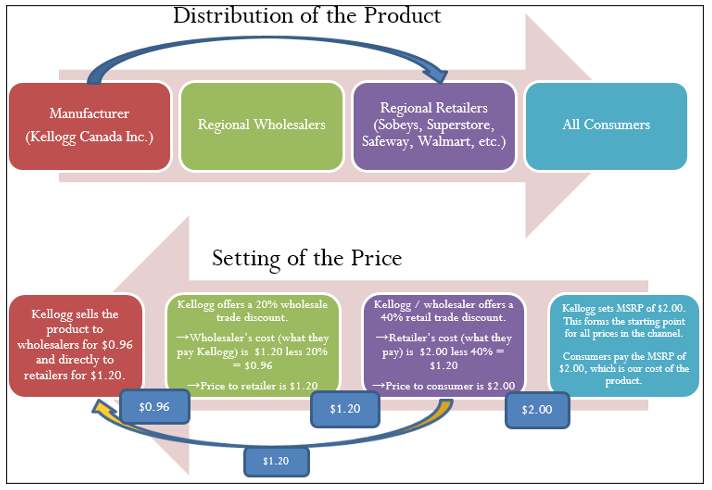
Start with distribution in the top half of the figure and work left to right. As an example, let’s look at a manufacturer such as Kellogg Canada Inc. (which makes such products as Pop-Tarts, Eggo Waffles, and Rice Krispies). Kellogg’s Canadian production plant is located in London, Ontario. To distribute its products to the rest of Canada, Kellogg Canada uses various regional wholesalers. Each wholesaler then resells the product to retailers in its local trade area; however, some retailers (such as the Real Canadian Superstore) are very large, and Kellogg Canada distributes directly to these organizations, bypassing the wholesaler as represented by the blue arrow. Finally, consumers shop at these retailers and acquire Kellogg products.
The relationship of distribution to pricing is illustrated in the bottom half of the figure, working right to left. For now, focus on understanding how pricing works; the mathematics used in the figure will be explained later in this chapter. Kellogg Canada sets a manufacturer’s suggested retail price, known as the MSRP. This is a recommended retail price based on consumer market research. Since grocery retailers commonly carry thousands or tens of thousands of products, the MSRP helps the retailer to determine the retail price at which the product should be listed. In this case, assume a $2.00 MSRP, which is the price consumers will pay for the product.
The retailer must pay something less than $2.00 to make money when selling the product. Kellogg Canada understands its distributors and calculates that to be profitable most retailers must pay approximately 40% less than the MSRP. Therefore, it offers a 40% discount. If the retailer purchases directly from Kellogg, as illustrated by the yellow arrow, the price paid by the retailer to acquire the product is $2.00 less 40%, or $1.20. Smaller retailers acquire the product from a wholesaler for the same price. Thus, the retailer’s cost equals the wholesaler’s price (or Kellogg Canada’s price if the retailer purchases it directly from Kellogg).
The wholesaler’s price is $1.20. Again, Kellogg Canada, knowing that the wholesaler must pay something less than $1.20 to be profitable, offers an additional 20% discount exclusively to the wholesaler. So the price paid by the wholesaler to acquire the product from Kellogg Canada is $1.20 less 20%, or $0.96. This $0.96 forms Kellogg Canada’s price to the wholesaler, which equals the wholesaler’s cost.
In summary, this discussion illustrates two key pricing concepts:
- Companies higher up in the distribution channel pay lower prices than those farther down the channel. Companies receive discounts off the MSRP based on their level in the distribution system. This may result in multiple discounts, such as a wholesaler receiving both the retailer’s discount and an additional discount for being a wholesaler.
- One organization’s price becomes the next organization’s cost (assuming the typical distribution channel structure):
-
- Manufacturer’s Price = Wholesaler’s Cost
- Wholesaler’s Price = Retailer’s Cost
- Retailer’s Price = Consumer’s Cost
Types of Discounts
You will perform discount calculations more effectively if you understand how and why single pricing discounts and multiple pricing discounts occur. Businesses or consumers are offered numerous types of discounts, of which five of the most common are trade, quantity, loyalty, sale, and seasonal.
Trade Discounts
A trade discount is a discount offered to businesses only based on the type of business and its position in the distribution system (e.g., as a retailer, wholesaler, or any other member of the distribution system that resells the product). Consumers are ineligible for trade discounts. In the discussion of the figure, two trade discounts are offered. The first is a 40% retail trade discount, and the second is a 20% wholesale trade discount. Typically, a business that is higher up in the distribution system receives a combination of these trade discounts. For example, the wholesaler receives both the 40% retail trade discount and the 20% wholesale trade discount from the MSRP. The wholesaler’s cost is calculated as an MSRP of $2.00 less 40% less 20% = $0.96.
Quantity Discounts
A quantity discount (also called a volume discount) is a discount for purchasing larger quantities of a certain product. If you have ever walked down an aisle in a Real Canadian Superstore, you probably noticed many shelf tags that indicate quantity discounts, such as “Buy one product for $2” or “Take two products for $3.” Many Shell gas stations offer a Thirst Buster program in which customers who purchase four Thirst Busters within a three-month period get the fifth one free. If the Thirst Busters are $2.00 each, this is equivalent to buying five drinks for $10.00 less a $2.00 quantity discount.
Loyalty Discounts.
A loyalty discount is a discount that a seller gives to a purchaser for repeat business. Usually no time frame is specified; that is, the offer is continually available. As a consumer, you see this regularly in marketing programs such as Air Miles or with credit cards that offer cash back programs. For example, Co-op gas stations in Manitoba track consumer gasoline purchases through a loyalty program and mails an annual loyalty discount cheque to its customers, recently amounting to 12.5¢ per litre purchased. In business-to-business circles, sellers typically reward loyal customers by deducting a loyalty discount percentage, commonly ranging from 1% to 5%, from the selling price.
Sale Discounts
A sale discount is a temporary lowering of the price from a product’s regular selling price. Businesses put items on sale for a variety of reasons, such as selling excess stock or attracting shoppers. You see such promotional events all the time: LED monitors are on sale at Best Buy; Blu-Ray discs are half off at Walmart; The Brick is having a door crasher event Saturday morning.
Seasonal Discounts
A seasonal discount is a discount offered to consumers and businesses for purchasing products out of season. At the business level, manufacturers tend to offer seasonal discounts encouraging retailers, wholesalers, or distributors to purchase products before they are in season. Bombardier Inc. manufactures Ski-Doos, which are sold in Canada from approximately November through March—a time of year when most of the country has snow and consumers would want to buy one. To keep production running smoothly from April through October, Bombardier could offer seasonal discounts to its wholesalers and retailers for the coming winter season. At a retail level, the examples are plentiful. On November 1 most retailers place their Halloween merchandise on seasonal discount to clear out excess inventory, and many retailers use Boxing Day (or Boxing Week) to clear their out-of-season merchandise.
Single Discounts
Let’s start by calculating the cost when only one discount is offered. Later in this section you will learn how to calculate a cost involving multiple discounts.
The Formula
 Figuring out the price after applying a single discount is called a net price calculation. When a business calculates the net price of a product, it is interested in what you still have to pay, not in what has been removed. Note in Formula 2.1 below that you take 1 and subtract the discount rate to determine the rate owing. If you are eligible for a 20% discount, then you must pay 80% of the list price, as illustrated in the figure to the right.
Figuring out the price after applying a single discount is called a net price calculation. When a business calculates the net price of a product, it is interested in what you still have to pay, not in what has been removed. Note in Formula 2.1 below that you take 1 and subtract the discount rate to determine the rate owing. If you are eligible for a 20% discount, then you must pay 80% of the list price, as illustrated in the figure to the right.
Formula 2.1
 Formula 2.1 once again applies Formula 2.2 on rate, portion, and base, where the list price is the base, the (1 – d) is the rate, and the net price represents the portion of the price to be paid.
Formula 2.1 once again applies Formula 2.2 on rate, portion, and base, where the list price is the base, the (1 – d) is the rate, and the net price represents the portion of the price to be paid.
Notice that Formula 2.1 requires the discount to be in a percentage (decimal) format; sometimes a discount is expressed as a dollar amount, though, such as “Save $5 today.” Formulas 2.2a and 2.2b relate the discount dollar amount to the list price, discount percent, and net price. Choose one formula or the other depending on which variables are known.
Formula 2.2

How It Works
Follow these steps to calculate the net price involving a single discount. These steps are adaptable if the net price is a known variable and one of the other variables is unknown.
Step 1: Identify any known variables, including list price, discount rate, or discount amount.
Step 2: If the list price is known, skip this step. Otherwise, solve for list price using an appropriate formula.
Step 3: Calculate the net price.
-
- If the list price and discount are are known, apply Formula 2.1.
- If the list price and discount amount are known, apply Formula 2.2b and rearrange for N.
Assume a product sells for $10 and is on sale at 35% off the regular price. Calculate the net price for the product.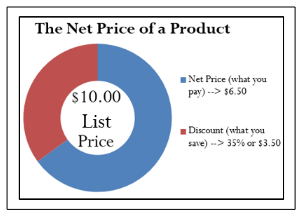
Step 1: The list price of the product is L = $10. It is on sale with a discount rate of d = 0.35.
Step 2: List price is known, so this step is not needed.
Step 3: Applying Formula 2.1 results in a new price of N = $10 × (1 – 0.35) = $6.50. Note that if you are interested in learning the discount amount, you apply Formula 2.2b to calculate D$ = $10 − $6.50 = $3.50.
Important Notes
You can combine Formula 2.1 and either version of Formula 2.2 in a variety of ways to solve any single discount situation for any of the three variables. As you deal with increasingly complicated pricing formulas, your algebraic skills in solving linear equations and substitution become very important.
Many of the pricing problems take multiple steps that combine various formulas, so you need to apply the PUPP model systematically. In any pricing problem, you must understand which variables are provided and match them up to the known formulas. To get to your end goal, you must look for formulas in which you know all but one variable. In these cases, solving for variables will move you forward toward solving the overall pricing problem.
If you find you cannot produce a formula with only one unknown variable, can you find two formulas with the same two unknowns? If so, you can use your algebraic skills to find the roots of the two equations simultaneously. Alternatively, you can solve one formula for a variable then substitute it into the other formula, allowing you to isolate the remaining variable. Throughout the examples in this chapter you will see many applications of these algebraic skills.
Things To Watch Out For
Remember to apply the rounding rules:
- Until you arrive at the final solution, avoid rounding any interim numbers unless you have some special reason to do so.
- Round all dollar amounts to the nearest cent. If the dollar amount has no cents, you may write it either without the cents or with the “.00” at the end.
- Round all percentages to four decimals when in percent format.
Paths To Success
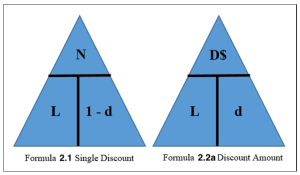 When working with single discounts, you are not always solving for the net price. Sometimes you must calculate the discount percent or the list price. At other times you know information about the discount amount but need to solve for list price, net price, or the discount rate. The triangle technique can remind you how to rearrange the formulas for each variable, as illustrated in the figure to the right.
When working with single discounts, you are not always solving for the net price. Sometimes you must calculate the discount percent or the list price. At other times you know information about the discount amount but need to solve for list price, net price, or the discount rate. The triangle technique can remind you how to rearrange the formulas for each variable, as illustrated in the figure to the right.
Examples
- Will you pay more than, less than, or exactly $10.00 for a product if you are told that you are paying:
- a net price of $10.00 when there is a discount of 25%?
- a list price of $10.00 when there is a discount of 25%?
- If an item is subject to a 40% discount, will the net price be more than or less than half of the list price of the product?
Solution
- Exactly $10. The net price is the price after the discount.
- Less than $10. The discount needs to be removed from the list price.
- More than half. A 40% discount means that you will pay 60% of the list price
Example 2.1A: Determining the Retailer’s Net Price for a Pair of Jeans
A manufacturer that sells jeans directly to its retailers uses market research to find out it needs to offer a 25% trade discount. In doing so, the retailers will then be able to price the product at the MSRP of $59.99. What price should retailers pay for the jeans?
Solution
Plan
Calculate how much a retailer should pay for the jeans after the regular price has been discounted to accommodate the trade discount. This is called the net price for the product, or N.
What You Already Know
Step 1: The list price and the discount rate are known:
L =$59.99d = 0.25
How You Will Get There
Step 2: List price is known, so skip this step.
Step 3: Apply Formula 2.1.
Perform
Step 3: N = $59.99 × (1 – 0.25) = $59.99 × 0.75 = $44.99
Present
The manufacturer should sell the jeans to the retailers for $44.99
Example 2.1B: Determining the List Price of a Jacket
Winners pays a net price of $27.50 for a winter jacket after receiving a retail trade discount of 45%. What was the MSRP of the jacket?
Solution
Plan
Calculate the MSRP for the jacket before Winners received the retail trade discount to arrive at the net price. This is called the list price for the product, or L.
What You Already Know
Step 1: The net price and the discount rate are known:
N = $27.50d = 0.45
How You Will Get There
Step 2: List price is the unknown variable; skip this step.
Step 3: Apply Formula 2.1, rearranging for L.
Perform
Step 3: $27.50 = L (1 – 0.45) L = $27.50 ÷ (1 – 0.45)
L = $27.50 ÷ 0.55 = $50.00
Present
The MSRP, or list price, of the winter jacket is $50.00.
You are shopping at Mountain Equipment Co-op for a new environmentally friendly water bottle. The price tag reads
$14.75, which is $10.24 off the regular price. Determine the discount rate applied.
Example 2.1C: Determining the Discount Percent and Discount Amount
You are shopping at Mountain Equipment Co-op for a new environmentally friendly water bottle. The price tag reads $14.75, which is $10.24 off the regular price. Determine the discount rate applied.
Solution
Plan
You need to find out how the sale price translates into the discount rate, or d.
What You Already Know
Step 1: The discount amount and net price are known:
D$ = $10.24N = $14.75
How You Will Get There
Step 2: Use Formula 2.2b to calculate the list price, rearranging for L.
Step 3: Convert the discount amount into a percentage by applying Formula 2.2a, rearranging for d.
Perform
Step 2: List price: $10.24 = L – $14.75, which results in L = $24.99 Step 3: Discount rate: d = D$ ÷ L
d = $10.24 = 0.409764 or 40.9764%
$24.99
Present
The water bottle today has been reduced in price by the amount of $10.24. This represents a sale discount of 40.9674%.
Multiple Discounts
You are driving down the street when you see a large sign at Old Navy that says, “Big sale, take an additional 25% off already reduced prices!” In other words, products on sale (the first discount) are being reduced by an additional 25% (the second discount). Because Formula 2.1 handles only a single discount, you must use an extended formula in this case.
The Formula
Businesses commonly receive more than one discount when they make a purchase. Consider a transaction in which a business receives a 30% trade discount as well as a 10% volume discount. First, you have to understand that this is not a 30% + 10% = 40% discount. The second discount is always applied to the net price after the first discount is applied. Therefore, the second discount has a smaller base upon which it is calculated. If there are more than two discounts, you deduct each subsequent discount from continually smaller bases. Formula 2.3 expresses how to calculate the net price when multiple discounts apply.
Formula 2.3 Multiple Discounts
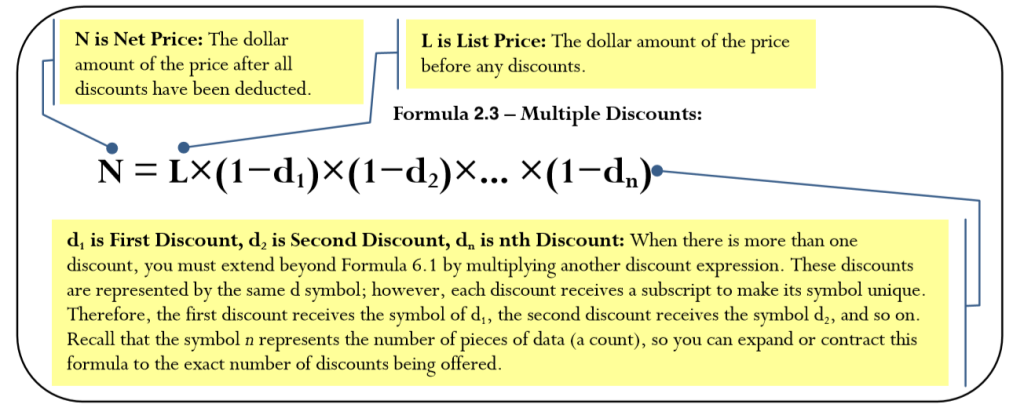
It is often difficult to understand exactly how much of a discount is being received when multiple discounts are involved. Often it is convenient to summarize the multiple discount percentages into a single percentage. This makes it easier to calculate the net price and aids in understanding the discount benefit. Simplifying multiple percent discounts into a single percent discount is called finding the single equivalent discount. Whether you apply the multiple discounts or just the single equivalent discount, you arrive at the same net price. The conversion of multiple discount percentages into a single equivalent discount percent is illustrated in Formula 2.4.
Formula 2.4
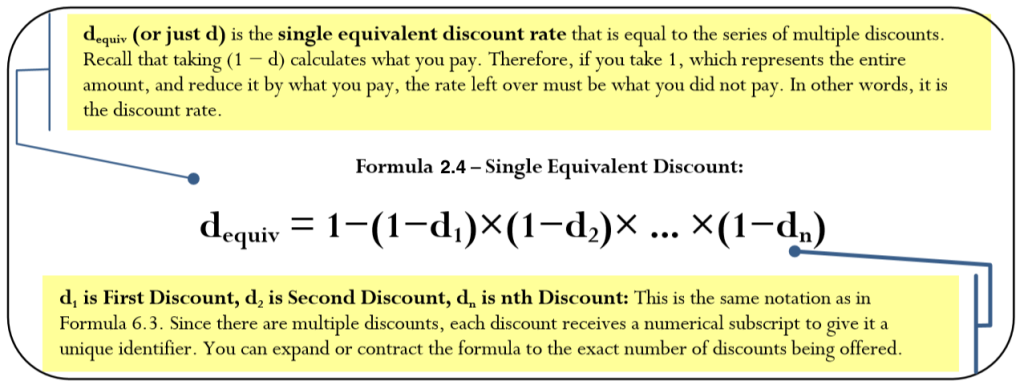
How It Works
Refer back to the steps in calculating net price. The procedure for calculating a net price involving a single discount extends to a more generic procedure involving multiple discounts. As with the single discount procedures, you can adapt the model if the net price is known and one of the other variables is unknown. Follow these steps to calculate the net price involving any number of discounts:
Step 1: Identify any known variables, including list price, discount rate(s), or discount amount.
Step 2: If the list price is known, skip this step. Otherwise, solve for list price.
-
- If only one discount is involved, apply Formula 2.2a.
- If more than one discount is involved, the discount amount represents the total discount amount received from all of the discounts combined. This requires you first to convert the multiple discount rates into an equivalent single discount rate using Formula 2.4 and then to apply Formula 2.2a.
Step 3: Calculate the net price.
-
- If the list price and only a single known discount rate are involved, apply Formula 2.1.
- If the list price and multiple discount rates are known and involved, apply Formula 2.3.
- If the list price and the total discount amount are known, apply Formula 2.2b and rearrange for N.
Assume a product with an MSRP of $100 receives a trade discount of 30% and a volume discount of 10%.
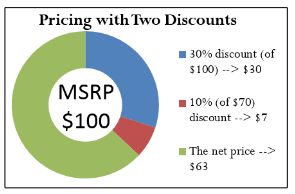
Calculate the net price.
- Step 1: The list price and discounts are L = $100, d1 = 0.30 and d2 = 0.10.
- Step 2: List price is known, so skip this step.
- Step 3: Apply Formula 2.3 to calculate the net price:
[latex]N = $100 × (1 − 0.30) × (1 − 0.10) = $63[/latex]
The net price is $63, which is illustrated above.
If you are solely interested in converting multiple discounts into a single equivalent discount, you need only substitute into Formula 2.4. In the above example, the product received a trade discount of 30% and a volume discount of 10%. To calculate the single equivalent discount, apply Formula 2.4:
[latex]d_{equiv} = 1 − (1 – 0.30) × (1 – 0.10)[/latex]
[latex]d_{equiv} = 1 − (0.70)(0.90)[/latex]
[latex]d_{equiv} = 1 – 0.63 = 0.37[/latex]
Therefore, whenever discounts of 30% and 10% are offered together, the single equivalent discount is 37%. Whether it is the multiple discounts or just the single equivalent discount that you apply to the list price, the net price calculated is always the same.
Important Notes
Order of Discounts: The order of the discounts does not matter in determining the net price. Remember from the rules of BEDMAS that you can complete multiplication in any order. Therefore, in the above example you could have arrived at the
$63 net price through the following calculation:
[latex]$100 × (1 − 0.10) × (1 − 0.30) = $63[/latex]
The order of the discounts does matter if trying to interpret the value of any single discount. If the trade discount is applied before the quantity discount and you are wanting to know the quantity discount amount, then the quantity discount needs to be second. Thus,
[latex]$100 x (1-0.30) = $70[/latex]
[latex]$70 x 0.10 = $7[/latex]
which is the amount of the quantity discount.
Price Does Not Affect Single Equivalent Discount
Notice in Formula 2.4 that the list price and the net price are not involved in the calculation of the single equivalent discount. When working with percentages, whether you have a net price of $6.30 and a list price of $10, or a net price of $63 and a list price of $100, the equivalent percentage always remains constant at 37%.
Things To Watch Out For
A common mistake when working with multiple discounts is to add the discounts together to calculate the single equivalent discount. This mistaken single discount is then substituted into Formula 2.1 to arrive at the wrong net price. Remember that if two discounts of 30% and 10% apply, you cannot sum these discounts. The second discount of 10% is applied on a smaller price tag, not the original price tag. To calculate the net price you must apply Formula 2.3.
Paths To Success
If you happen to know any two of the net price (N), list price (L), or the total discount amount (D$), then you could also use Formula 2.2 to solve for the single equivalent discount, dequiv. For example, if you know the net price is $63 and the total discount amount for all discounts is $37, you could use Formula 2.2b to figure out that the list price is $100, then convert the discount amount into a percentage using Formula 2.2a. This method will also produce a single equivalent discount of 37%.
Another method of calculating the single equivalent discount is to recognize Formula 2.2a as an application involving percent change. The variable d is a discount rate, which you interpret as a negative percent change. The discount amount, D$, is the difference between the list price (representing the Old price) and the net price (representing the New price after the discount). Therefore, Formula 2.2a can be rewritten as follows:
| D$ = L X d |
| becomes |
| New – Old = Old x % |
| [latex]\frac{\text New - Old}{\text Old}=\bigtriangleup\%[/latex] |
Therefore, any question about a single equivalent discount where net price and list price are known can be solved as a percent change. Using our ongoing net price example, you have:
[latex]\frac{$63 - $100}{$100}= -0.37 \text or -37\%[/latex]
This is a discount of 37%.
Give It Some Thought
If you are offered discounts in the amount of 25%, 15%, 10%, and 5%, will your total discount percent be 55%, less than 55%, or more than 55%?
Solution
Example 2.1D: Retailer Purchasing Ski-Doos with Multiple Discounts
A retail dealership purchases some Expedition TUV Yeti II Ski-Doos to stock in its stores. Examining the merchandising terms of the manufacturer, Bombardier, the dealership notices that it would be eligible to receive a 35% trade discount, 15% volume discount, and 3% loyalty discount. Because it is June and Ski-Doos are out of season, Bombardier offers a seasonal discount of 12% for purchases made before June 30. If the MSRP for the Ski-Doo is $12,399.00 and the dealership purchases this item on June 15, what price would it pay?
Solution
Plan
You are looking for the net price that the retail dealership will pay for the Ski-Doo, or N.
What You Already Know
Step 1: The retail dealership is eligible for all four discounts (it qualifies for the seasonal discount since it is purchasing before June 30).
Therefore,L = $12,399.00, d1 = 0.35, d2 = 0.15, d3 = 0.03,and d4 = 0.12
How You Will Get There
Step 2: You know the list price, so skip this step.
Step 3: Apply Formula 2.3.
Perform
Step 3: N = $12,399 × (1 – 0.35) × (1 – 0.15) × (1 – 0.03) × (1 – 0.12)
N = $12,399 × 0.65 × 0.85 × 0.97 × 0.88 = $5,847.54
Present
After all four discounts, the retail dealership could purchase the Ski- Doo for $5,847.54.
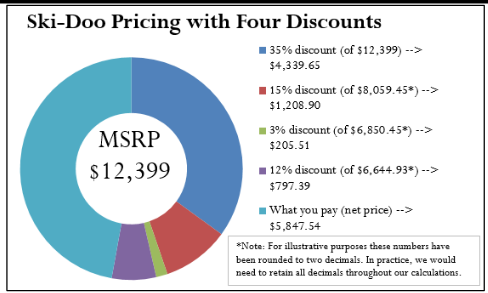
Example 2.1E: Reducing Multiple Discounts to a Single Equivalent Discount
The retail dealership in Example 2.1D purchases more products subject to the same discounts. It needs to simplify its calculations. Using the information from Example 2.1D, what single equivalent discount is equal to the four specified discounts?
Solution
Plan
You are looking for a single equivalent discount that is equal to the four discount percentages, or dequiv (or just d).
What You Already Know
You know the discount rates:
d1 = 0.35, d2 = 0.15, d3 = 0.03, and d4 = 0.12
How You Will Get There
Apply Formula 2.4.
Perform
dequiv = 1 − (1 – 0.35) × (1 – 0.15) × (1 – 0.03) × (1 – 0.12)
dequiv = 1 − (0.65)(0.85)(0.97)(0.88) = 1 – 0.471614 = 0.528386 or 52.8386%
Present
The retail dealership can apply a 52.8386% discount to all the products it purchases.
Example 2.1F: Making a Smart Consumer Purchase
You are shopping on Boxing Day for an 80″ HDTV. You have just one credit card in your wallet, a cashback Visa card, which allows for a 1% cash rebate on all purchases. While scanning flyers for the best deal, you notice that Visions is selling the TV for $5,599.99 including taxes, while Best Buy is selling it for $5,571.99 including taxes. However, because of a computer glitch Best Buy is unable to accept Visa today. Where should you buy your television?
Solution
Plan
You want to know which store you should buy the television at. You must calculate the net price (N) for each of the stores.
What You Already Know
Step 1: You know the list price for each of the stores. You also know the discount available from Visa. Thus,
LBest Buy = $5,571.99 with no discounts since Visa cannot be used there
LVisions = $5,599.99, d = 0.01, since you can use your Visa card there
How You Will Get There
Step 2: List price is known, so skip this step.
Step 3: Apply Formula 2.1.
Perform
Step 3: Best Buy: No discounts apply, so the list price equals the net price and N = $5,571.99.
Visions: N = $5,599.99 × (1 – 0.01) = $5,599.99 × 0.99 = $5,543.99
Present
The net price for Visions is $5,543.99. You save $5,571.99 – $5,543.99 = $28.00 by purchasing your TV at Visions.
Example 2.1G: Understanding the Price
An advertisement claims that at 60% off, you are saving $18. However, today there is an additional 20% off. What price should you pay for this item? What percent savings does this represent?
Solution
Plan
You are looking for how much you should pay after the discounts (N), and the single equivalent percentage that represents the two discounts (dequiv or just d).
What You Already Know
Step 1: You know the discount amount for the first discount only, as well as the two discount rates: D$1 = $18, d1 = 0.60, and d2 = 0.20.
How You Will Get There
Step 2: Calculate the list price by applying Formula 2.2a and rearranging for L.
Step 3: To calculate the net price, apply Formula 2.3. Step 4: To calculate the single equivalent discount, apply Formula 2.4.
Perform
Step 2: $18.00 = L × 0.60
L = $18.00 ÷ 0.6 = $30.00
Step 3: N = $30 × (1 – 0.60) × (1 – 0.20) = $30 × 0.40 × 0.80 = $9.60 Step 4: dequiv = 1 − (1 – 0.60) × (1 – 0.20) = 1 − (0.40)(0.80) = 1 – 0.32 = 0.68 or 68%
Present
You should pay $9.60 for the item, which represents a 68
Exercises
Round all money to two decimals and percentages to four decimals in each of the following questions.
Mechanics
For questions 1–4, solve for the unknown variables (identified with a ?) based on the information provided. “N/A” indicates that the particular variable is not applicable in the question.
| Question | List Price of MRSP | First Discount | Second Discount | Third Discount | Net price | Equivalent Single Discount Rate | Total Discount Amount |
| 1. | $980.00 | 42% | N/A | N/A | ? | N/A | ? |
| 2. | ? | 25% | N/A | N/A | $600.00 | N/A | ? |
| 3. | $1,975.00 | 25% | 15% | 10% | ? | ? | ? |
| 4. | ? | 18% | 4% | 7% | $366.05 | ? | ? |
Applications
- A wholesaler of stereos normally qualifies for a 35% trade discount on all electronic products purchased from its manufacturer. If the MSRP of a stereo is $399.95, what net price will the wholesaler pay?
- Mary is shopping at the mall where she sees a sign that reads, “Everything in the store is 30% off, including sale items!” She wanders in and finds a blouse on the clearance rack. A sign on the clearance rack states, “All clearance items are 50% off.” If the blouse is normally priced at $69.49, what price should Mary pay for it?
- A distributor sells some shoes directly to a retailer. The retailer pays $16.31 for a pair of shoes that has a list price of $23.98. What trade discount percent is the distributor offering to its retailers?
- A retailer purchases supplies for its head office. If the retailer pays $16.99 for a box of paper and was eligible for a 15% volume discount, what was the original MSRP for the box of paper?
- Mountain Equipment Co-op has purchased a college backpack for $29 after discounts of 30%, 8%, and 13%. What is the MSRP for the backpack? What single discount is equivalent to the three discounts?
- Walmart purchased the latest CD recorded by Selena Gomez. It received a total discount of $10.08 off the MSRP for the CD, which represents a discount percent of 42%.
- What was the MSRP?
- What was the net price paid for the CD?
- Best Buy just acquired an HP Pavilion computer for its electronics department. The net price on the computer is $260.40 and Best Buy receives discounts of 40% and 38%.
- What single discount is equivalent to the two discounts?
- What is the list price?
- What is the total discount amount?
- TELUS retails a Samsung cellphone at the MSRP of $399.99. TELUS can purchase the phone from its supplier and receive a 20% trade discount along with a 5% volume discount.
- What is the single equivalent percent discount?
- What net price does TELUS pay for the phone?
- How much of a discount in dollars does this represent?
- A wholesaler offers the following discounts: 10% seasonal discount for all purchases made between March 1 and May 1, 15% cumulative quantity discount whenever more than 5,000 units are purchased in any month, 5% loyalty discount for customers who have made regular purchases every month for at least one year, and a 33% trade discount to any retailer. Ed’s Retail Superstore makes a purchase of 200 watches, MSRP $10, from the wholesaler on April 29. This month alone, Ed’s has ordered more than 5,000 watches. However, Ed’s has purchased from the wholesaler for only the past six months. Determine the total price that Ed’s should pay for the watches.
- If a distributor is eligible for a 60% trade discount, 5% volume discount, and 3% seasonal discount, what single equivalent discount rate would it be eligible to receive? If the trade discount is applied first and equals a trade discount of $48, calculate the net price for the item.
Challenge & Critical Thinking
As mentioned in one of the “Paths to Success” sections, discount percentages share a commonality with negative percent changes (Section 3.1). Use the formulas from this chapter to solve questions 15–17 involving percent change.
- A human resource manager needs to trim labour costs in the following year by 3%. If current year labour costs are $1,231,498, what are the labour costs next year?
- At an accounting firm, the number of accountants employed is based on the ratio of 1:400 daily manual journal entries. Because of ongoing increases in automation, the number of manual journal entries declines at a constant rate of 4% per year. If current entries are 4,000 per year, how many years and days will it take until the firm needs to lay off one accountant? (Hint: An accountant is laid off when the number of journal entries drops below 3,600.)
- An economist is attempting to understand how Canada reduced its national debt from 1999 to 2008. In 1999, Canada’s national debt was $554.143 billion. In 2008, the national debt stood at $457.637 billion. What percentage had the national debt been reduced by during this time period?
- Sk8 is examining an invoice. The list price of a skateboard is $109.00, and the invoice states it received a trade discount of 15% and quantity discount of 10% as well as a loyalty discount. However, the amount of the loyalty discount is unspecified.
- If Sk8 paid $80.88 for the skateboard, what is the loyalty discount percent?
- If the loyalty discount is applied after all other discounts, what amount of loyalty dollars does Sk8 save per skateboard?
- Currently, a student can qualify for up to six different tuition discounts at a local college based on such factors as financial need or corporate sponsorships. Mary Watson just applied to the college and qualifies for all six discounts: 20%, 15%, 23%, 5%, 3%, and 1%.
- She is confused and wants the college to tell her what single discount percent she is receiving. What should the college tell her?
- If her total list tuition comes to $6,435.00, how much should she pay?
- Sumandeep is very loyal to her local hairstylist. Because she is loyal, her hairstylist gives her three different discounts: 10%, 5%, and 5%. These discounts amount to $14.08 in savings.
- What was the list price her hairstylist charged her?
- What amount did she pay her hairstylist?
- If her hairstylist increases prices by 5%, what are the list price, net price, and total discount amount?
Answers
Chapter Attribution
Adapted from unit 6.1 in Business Math: A Step-by-Step Handbook

